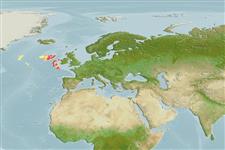Holocephali (quimeras) (chimaeras) >
Chimaeriformes (Chimaeras) >
Chimaeridae (Shortnose chimaeras or ratfishes)
Etymology: Chimaera: Named for the mythological creature composed of parts of multiple animals, referring to their odd mix of characteristics (See ETYFish); opalescens: Latin for opalescent, referring to characteristic iridescent coloration of fresh specimens, resembling nacreous colors of the semi-precious stone opal (See ETYFish).
Environment: milieu / climate zone / depth range / distribution range
Ecologia
marinhas batidemersal; intervalo de profundidade 900 - 1408 m (Ref. 87424). Temperate; 57°N - 48°N, 6°W - 11°W
Northeast Atlantic, along the slope to the west of the British Isles and France (Ref. 87424).
Tamanho / Peso / Idade
Maturity: Lm ? range ? - ? cm
Max length : 96.8 cm TL macho/indeterminado; (Ref. 87424); 109.8 cm TL (female)
Descrição suscinta
Chaves de identificação | Morfologia | Morfometria
Chimaera opalescens can be distinguished from its congeners by the following combination of characters: body evenly coloured, iridescent, varying from beige to tan in adults and bronzish in juveniles; unpaired fins brown to purple, uniformly coloured or with pale or whitish edges; iris black; claspers tripartite divided for one third of their length, not extending beyond the pelvic fins in adults; dorsal spine equal or shorter than first dorsal fin; ventral caudal lobe equal or deeper than the dorsal caudal lobe. Comparison of DNA sequences of the CO1 gene with those of related species supported C. opalescens as a distinct species (Ref. 87424).
Ciclo de vida ou comportamento de acasalamento
Maturidade | Reprodução | Desova | Ovos | Fecundidade | Larvas
Luchetti, E.A., S.P. Iglésias and D.Y. Sellos, 2011. Chimaera opalescens n. sp., a new chimaeroid (Chondrichthyes: Holocephali) from the north-eastern Atlantic Ocean. J. Fish Biol. 79(2):399-417. (Ref. 87424)
Status na Lista Vermelha da UICN (Ref. 130435: Version 2024-1)
Ameaça para os humanos
Harmless
Uso pelos humanos
Ferramentas
Relatórios especiais
Baixar XML
Fontes da internet
Estimates based on models
Preferred temperature (Ref.
123201): 7 - 9, mean 8.3 °C (based on 6 cells).
Índice de diversidade filogenética (Ref.
82804): PD
50 = 0.5000 [Uniqueness, from 0.5 = low to 2.0 = high].
Bayesian length-weight: a=0.00331 (0.00137 - 0.00798), b=3.07 (2.86 - 3.28), in cm total length, based on LWR estimates for this (Sub)family-body shape (Ref.
93245).
Nível Trófico (Ref.
69278): 3.7 ±0.6 se; based on size and trophs of closest relatives
Resiliência (Ref.
120179): Muito baixo(a), tempo mínimo de duplicação da população maior que 14 anos (Preliminary K or Fecundity.).
Fishing Vulnerability (Ref.
59153): High to very high vulnerability (66 of 100).
Nutrients (Ref.
124155): Calcium = 12.5 [3.9, 36.9] mg/100g; Iron = 0.281 [0.104, 1.093] mg/100g; Protein = 15.3 [10.4, 19.0] %; Omega3 = 0.495 [0.216, 1.141] g/100g; Selenium = 21.7 [5.9, 59.4] μg/100g; VitaminA = 9.21 [2.75, 29.32] μg/100g; Zinc = 0.429 [0.217, 0.804] mg/100g (wet weight);
